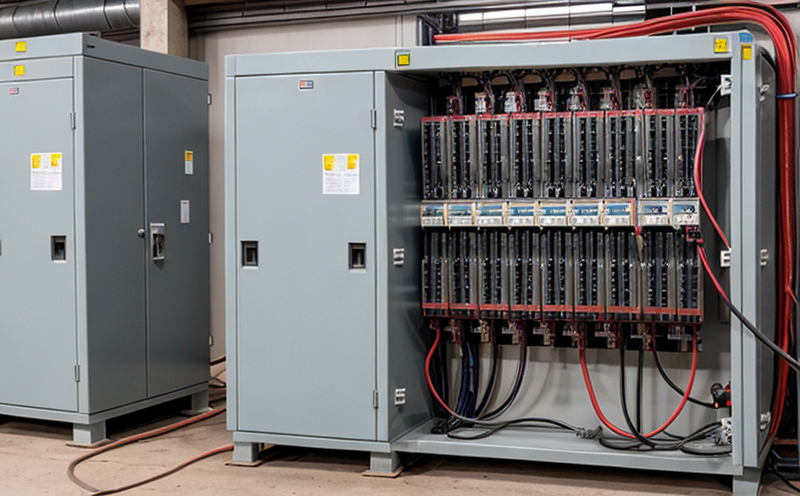IEEE C57.21 Shunt Reactor Testing in Power Systems
The IEEE C57.21 standard provides a comprehensive framework for testing shunt reactors, which are critical components in power systems designed to improve voltage stability and mitigate reactive power issues. These reactors are essential for ensuring that the power distribution network operates efficiently and reliably under varying conditions.
Shunt reactors are typically found in substations where they provide reactive compensation by absorbing excess reactive currents. This helps prevent overvoltage conditions, particularly during peak load periods when reactive demand is high. The IEEE C57.21 standard ensures that these devices meet stringent performance criteria to guarantee their safety and reliability.
Testing according to this standard involves a series of procedures aimed at evaluating the electrical characteristics, mechanical integrity, and thermal stability of shunt reactors. Key parameters include insulation resistance, dielectric strength, short-circuit endurance, and temperature rise during operation. Compliance with these tests not only ensures regulatory adherence but also enhances system reliability and longevity.
Regular inspection and testing are crucial for maintaining the integrity of power systems. By adhering to IEEE C57.21, utilities can identify potential issues early on, preventing costly outages and ensuring optimal performance of their infrastructure.
The standard is widely recognized in the industry due to its rigorous approach to quality assurance. It mandates that all tests be conducted by certified laboratories using state-of-the-art equipment and methodologies. This ensures consistent and accurate results across different installations.
In summary, IEEE C57.21 Shunt Reactor Testing plays a vital role in safeguarding power systems against failures due to aging components or improper installation practices. By implementing this testing protocol, utilities can maintain high levels of service reliability while complying with international safety standards.
Why It Matters
The significance of IEEE C57.21 Shunt Reactor Testing cannot be overstated in the context of modern power systems. Given the increasing complexity and size of these networks, ensuring that shunt reactors operate correctly is paramount to preventing widespread outages and maintaining grid stability.
- Prevents equipment failure leading to costly downtime
- Maintains voltage levels within acceptable limits
- Averts potential risks associated with excessive reactive power
- Enhances overall system efficiency by optimizing load flow
- Safeguards against insulation breakdowns which can cause fires or explosions
- Complies with regulatory requirements imposed by national and international standards bodies
The importance of this testing cannot be understated. It contributes significantly to the reliability, safety, and efficiency of power systems, thereby protecting both the infrastructure itself and the communities it serves.
Benefits
- Enhanced System Reliability: Ensures that shunt reactors are functioning optimally, reducing the risk of unexpected failures.
- Regulatory Compliance: Adherence to international standards like IEEE C57.21 ensures compliance with legal requirements.
- Cost Efficiency: Early detection and rectification of issues can prevent significant financial losses from prolonged outages or replacements.
- Increased Safety: By identifying potential hazards, this testing helps protect personnel and equipment from damage.
- Better Performance Monitoring: Continuous monitoring allows for proactive maintenance strategies that extend the lifespan of assets.
- Improved Voltage Stability: Ensures stable voltage levels throughout the network, promoting efficient energy distribution.
The benefits extend beyond immediate operational improvements; they contribute to long-term sustainability and resilience in power systems. Investing in thorough testing not only meets current needs but also prepares infrastructure for future challenges posed by climate change and technological advancements.
Why Choose This Test
Selecting IEEE C57.21 Shunt Reactor Testing is a prudent decision for several compelling reasons. Firstly, the standard provides a robust set of guidelines that cover all aspects of reactor testing, from initial inspections to routine maintenance checks.
- Comprehensive Coverage: The standard includes detailed procedures covering electrical tests, mechanical evaluations, and thermal assessments.
- Expert Certification: Only laboratories accredited by recognized bodies perform these tests, ensuring high-quality results.
- Global Acceptance: Adhering to IEEE standards means your testing meets international benchmarks, enhancing credibility.
- Proactive Approach: Regular testing facilitates early identification of potential problems before they escalate into major issues.
In conclusion, choosing IEEE C57.21 Shunt Reactor Testing is not just about meeting regulatory obligations; it’s a strategic move towards maintaining robust power systems capable of withstanding various operational stresses.





